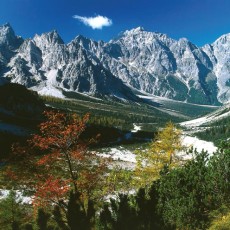Famous mountains and personalities
A mountaineering introduction to the Ramsau
Isn’t it remarkable how many men of the cloth have influenced the beginnings of Alpinism? In any case, they surely did so in Ramsau. In August of 1800, the Watzmann, one of the German Alps’ most symbolic mountains, was scaled by the prospective priest, Valentin Stanic of Slovenia. His motivation was mainly scientific in nature: wanting to determine the geographic position of the summit. Just a few decades later, the high-‐ranking officer Friedrich Johann Joseph Celestin Fürst zu Schwarzenberg – and future Archbishop of Salzburg – lost his heart to the snowy white peaks of the Berchtesgadener Land. During his Theology studies, he scaled the Hundstod in 1825 and in 1830 both the Schönfeld and Hochkalter peaks, the latter via a route located on the western side which is barely accessible today. And three years later, Theologist Peter Karl Thurwieser – called by some “Bergnarr im Priesterrock” (literal translation: passionate mountaineer in a Priest’s Gown) – completed his Hochkalter ascent via the “schönen Fleck”, what is known today as the common route; with 2nd degree of difficulty climbing sections. Thurwieser’s idea of mountain appreciation corresponds quite similarly to our own today: he may be viewed as one of the first “pleasure climbers” who’s main motivation was the pure enjoyment of the trek rather than having a specific goal. And once he reached the peak, he was known for firing off his self-made fireworks – a custom which would definitely appear quite strange today.
The first Watzmann-Ostwand (east wall) climb was accomplished in 1881 by Johann Grill, also known as “Kederbacher“ – as an exception, not a man of the cloth but a farmer and lumberjack from Ramsau. As Germany’s first certified mountain guide, he had led treks with renowned climbing greats such as Johann Stüdl, Eduard Richter, Karl Blodig and Ludwig Purtscheller.
“A calm summer night passed over the mountains and day was waiting to break. A grey light fell upon the motionless tops of the spruce trees draped with moss, piercing the gaps of the steep forest wall. Breaking the utter silence was the sporadic, mild chirping of birds. At times, a bright clink rose through the forest as the two men ascended the trail and the tips of their alpenstocks hit stone as they pierced through the cover of moss.“
It is this narration by late-Romantic author Ludwig Ganghofer which comes to mind as we begin our ascent of the Hochkalter eastern flank through a sparse mountain forest at the crack of dawn. The Eckau-Alm (mountain pasture) is well below us by now and soon we will reach the thyme scented sheep pastures of the Hochalm. Today we plan on scaling the Schärtenspitze (Schärten Peak) via the Eisbodenscharte (Eisboden Gap) to complete an ample round trip via the Blaueis Hut back to the valley. We are deep in the belly of the Berchtesgaden National Park which has a particular founding history: as the discussion regarding a Watzmann passenger lift recommenced in the 1960s, the nature conservation organisations – including the German Alpine Club (Deutscher Alpenverein) – stood their ground until the Bavarian government gave the national park plan the green light – and with it, the lift project was finally history.
We step into the shining morning light. The Sun has risen above the mighty Watzmann massif and has formed the fine column-‐like contours of the Blaueis peak. The morning wind combs the wool of the sheep, which don’t pay any attention to us as they scythe through the flowery meadows, and we continue on through a gully cobbled with grey rubble leading up to Schärten Peak. Not long after we are standing on a small peak adorned with a modest cross and are surrounded by famous monumental mountain figures: Blaueisspitze and Hochkalter, the southern earth slides of the Reiter Steinberge, the gentle form of the Latten mountains, further out, the south wall of the Untersberge, the Göll massif and last but not least, the banding stone walls of the Watzmann: offering countless possibilities which can fill any mountain climber’s lifetime.
Text: R. Kals, Translation: D. del Gesso









